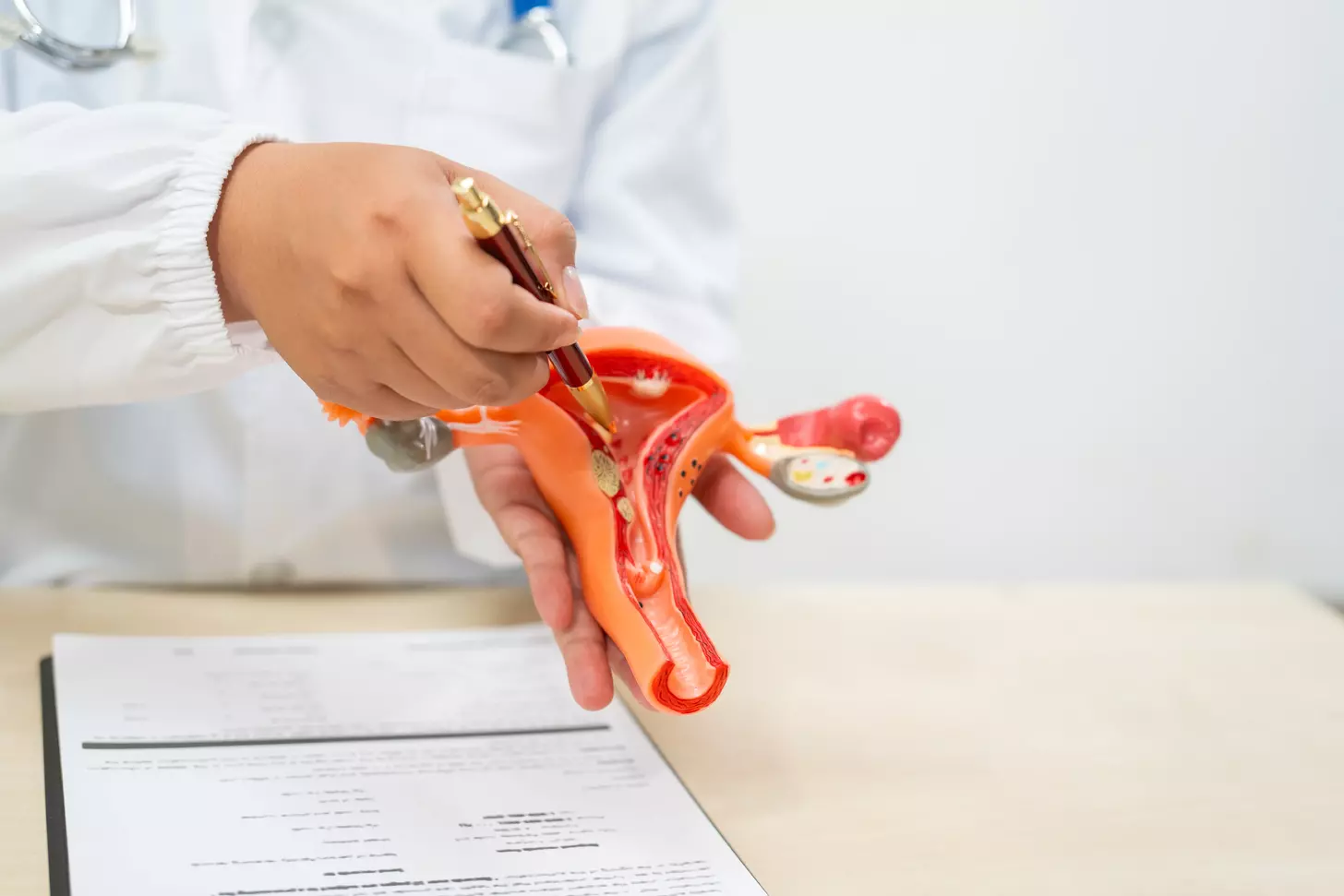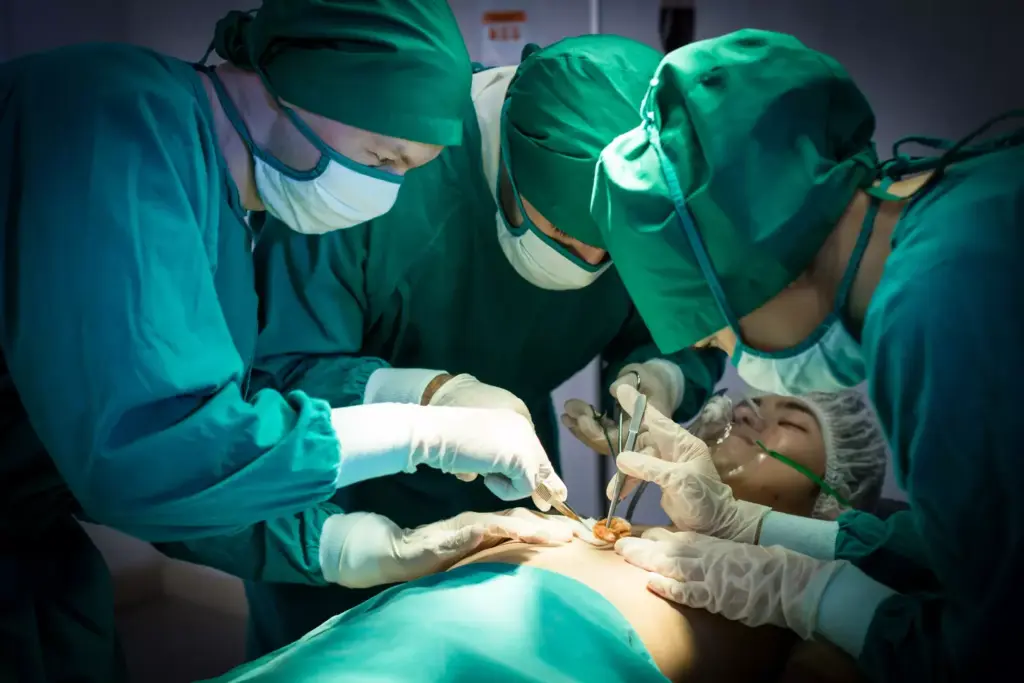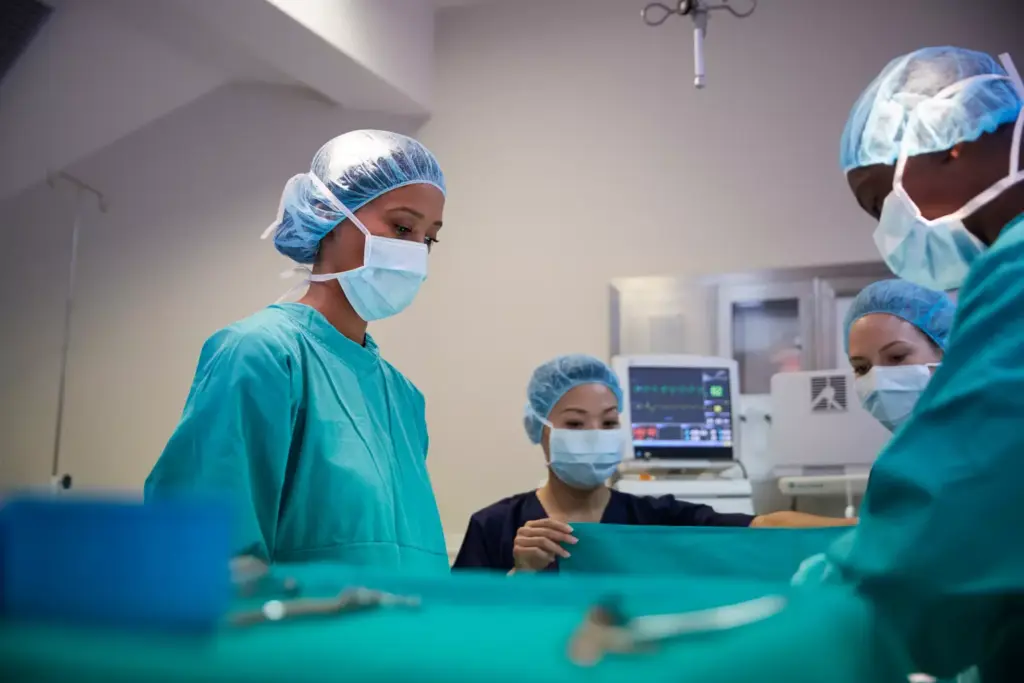Last Updated on November 4, 2025 by Bilal Hasdemir

At Liv Hospital, we focus on innovative, patient-centered care. We use advanced medical procedures like laparoscopic hysterectomy surgery. This method removes the uterus through small incisions and a camera.
This approach cuts down on postoperative pain and recovery time. It’s much better than traditional open surgery.
Choosing hysterectomy total laparoscopic surgery is a big decision. Our team of experts is here to guide you every step of the way. We ensure you get the best care possible.
By opting for a laparoscopic total hysterectomy, you get smaller incisions. This means less tissue damage and a faster return to your normal activities.

Laparoscopic hysterectomy is a new way to remove the uterus. It uses small cuts in the belly instead of a big one. This method is less invasive than old ways, making recovery faster and less painful.
Minimally invasive surgery, like laparoscopic hysterectomy, aims to use the smallest cuts possible. This reduces damage and helps healing. It uses special tools and a camera to see inside the body. This way, patients feel less pain and get back to life sooner.
The first laparoscopic hysterectomy was done in the late 1980s. It started a new chapter in gynecology. Over time, tools and techniques have improved a lot. Now, we can do more complex surgeries safely and accurately.
In the U.S., laparoscopic hysterectomy is getting more popular. More and more hysterectomies are done this way. In some places, over 60% of hysterectomies are laparoscopic. This shows more doctors and patients are choosing this method.

Laparoscopic hysterectomy is a popular choice for many. It’s known for being minimally invasive and having fewer complications. This method helps patients recover faster and improves their overall health.
This surgery uses smaller cuts, leading to less pain after. Patients can get back to their daily lives sooner.
Less pain and quicker recovery are big pluses. Studies show patients heal faster with this method than with open surgery.
It also means less blood lost during surgery. The laparoscope helps surgeons spot and stop bleeding better. This cuts down on the need for blood transfusions.
| Benefits | Laparoscopic Hysterectomy | Open Hysterectomy |
|---|---|---|
| Postoperative Pain | Less pain | More pain |
| Recovery Time | Faster recovery | Slower recovery |
| Blood Loss | Less blood loss | More blood loss |
Surgeons use different types of laparoscopic hysterectomy, each with its own benefits. The choice depends on the patient’s health, the surgeon’s skills, and the case’s needs.
Total Laparoscopic Hysterectomy removes the uterus and cervix through small cuts. It’s done with a laparoscope for clear views. TLH is known for being less painful and leading to quicker healing.
Laparoscopic Supracervical Hysterectomy takes out the top part of the uterus but keeps the cervix. It’s chosen for those needing a less invasive method. LSH often means less pain and faster recovery.
| Procedure | Description | Benefits |
|---|---|---|
| Total Laparoscopic Hysterectomy (TLH) | Removal of the uterus and cervix | Minimally invasive, less postoperative pain |
| Laparoscopic Supracervical Hysterectomy (LSH) | Removal of the upper part of the uterus | Less morbidity, faster recovery |
| Laparoscopic-Assisted Vaginal Hysterectomy (LAVH) | Combination of laparoscopic and vaginal approaches | Flexibility in complex cases, reduced recovery time |
Laparoscopic-Assisted Vaginal Hysterectomy mixes laparoscopic and vaginal surgery. It’s great for complex cases. It uses laparoscopy for initial steps and then vaginal removal.
Each procedure has its own use, benefits, and risks. The right choice depends on the patient’s health, the surgery needed, and the surgeon’s skills.
To make sure laparoscopic hysterectomy goes well, we need to prepare carefully. We check the patient’s health and medical history. We also do tests to find any risks or problems.
Choosing the right patient is key. We look at their medical history, current health, and past surgeries. This helps us see if they’re a good fit for the surgery.
We do a full physical exam and look at their medical history. We also check their symptoms and why they need the surgery. This could be because of uterine fibroids, endometriosis, or heavy bleeding.
Tests and images are important before surgery. We do blood tests and check for bleeding problems. This helps us understand the patient’s health better.
Ultrasound and MRI help us see the uterus and any issues. These images help us plan the surgery and get ready for any challenges.
By carefully checking patients and doing tests, we make sure they’re ready for surgery. This helps lower the risk of problems.
For a successful laparoscopic hysterectomy, the operating room setup is key. It must be well-organized. This ensures surgeons have the best view and access to the uterus.
The tools used in laparoscopic hysterectomies are special. They help make the surgery less invasive. These include:
To learn more about the equipment and techniques, check out this detailed guide.
The way the operating room is set up is very important. It affects the success of the surgery. This includes:
By making sure the operating room is set up right, surgeons can do laparoscopic hysterectomies better. They can work more efficiently and accurately.
Surgical techniques are key to the success of laparoscopic hysterectomy. The skill of the surgeon is what makes this surgery work. They must use precise techniques at every step.
The first steps in laparoscopic hysterectomy are very important. We use different methods to safely enter the belly. The choice depends on the patient and the surgeon.
Veress Needle Technique: One way is the Veress needle technique. It uses a needle to create air in the belly. But, it must be done carefully to avoid problems.
Open Technique: Another method is the open technique. It makes a small cut to insert the first tool. This can lower the risk of injury to blood vessels or the bowel.
After getting in, we start the dissection and move the uterus. We use special tools to cut the attachments and move the uterus. This makes it easier to take it out.
Good laparoscopic dissection and uterine mobilization are vital. These advanced techniques help our patients recover faster.
Laparoscopic hysterectomy is usually safe but can have complications. These need quick and effective handling. The surgical team must be very skilled and ready for any unexpected problems.
Vascular injuries are a serious issue during laparoscopic hysterectomy. Prompt recognition and control of bleeding are key to avoid big blood loss and keep the patient safe. We use advanced laparoscopic tools and methods to stop bleeding. Sometimes, we might need to switch to an open surgery to manage bleeding well.
Urinary tract injuries, like bladder or ureter damage, are another risk. Careful dissection and identifying structures help lower injury risk. If injuries happen, we use specific repair methods based on the injury’s nature and size. This ensures the best results for patients.
Handling complications well is vital for laparoscopic hysterectomy success. Being ready for issues and using advanced techniques helps reduce risks. This way, we can give our patients the best care possible.
The first step in laparoscopic hysterectomy is very important. It affects how safe and effective the surgery is. There are two main ways to start: the Veress needle technique and the open technique.
The Veress needle technique is a closed method. It uses a Veress needle to make a pneumoperitoneum. This method is popular because it’s quick and easy. But, it can cause injuries to the bowel or blood vessels if not done right.
Using the Veress needle has some benefits. It lowers the chance of infection and causes less damage to tissues. But, it’s important to insert it carefully to avoid risks.
The open technique, also known as the Hasson technique, makes a small cut. Then, it lets you see the peritoneal cavity before putting in the laparoscope. This method is safer for people who have had surgery before or have adhesions.
The open technique gives you more control over where you start. This might lower the risk of injury to important structures. But, it could lead to a higher chance of infection and longer surgery times.
We will walk you through the steps of TLH, a minimally invasive surgery. Total Laparoscopic Hysterectomy is a precise technique. It requires skill and a deep understanding of the process.
The first step is a detailed pelvic survey. This checks for any issues or adhesions. A laparoscope is used to examine the pelvic cavity.
Any adhesions or scar tissue are then removed. This is called adhesiolysis. It’s important to clear the area for a smooth procedure.
After the survey, the round ligament is divided. This is done with laparoscopic tools for precise work. It helps move the uterus for easier removal.
This step is key to the success of TLH.
The next step is to stop bleeding by ligation of the uterine arteries. This is done with clips or electrocautery. Then, a colpotomy is performed.
This involves making a vaginal incision. It allows the uterus to be removed through the vagina. This completes the hysterectomy.
During TLH, the surgeon must be ready for any complications. By following these steps and using advanced techniques, surgeons can achieve a successful outcome for patients.
Removing the uterus through laparoscopy depends on good specimen retrieval methods. After the hysterectomy, the uterus must be taken out of the belly carefully. This is to prevent problems and help the patient recover well.
Vaginal extraction is a common way to take out the uterus after laparoscopic hysterectomy. This method is less invasive than others. Surgeons make a small cut in the vagina to remove the uterus.
This method has benefits like less chance of wound problems and better looks. But, it might not work for everyone, like those with big uteri or certain body shapes.
Morcellation is used for bigger specimens that can’t go through the vagina or a small cut. It cuts the specimen into smaller pieces for easier removal through a small incision.
Surgeons must think about the good and bad of morcellation. There’s a risk of spreading tissue pieces in the belly. To lower this risk, surgeons use bags to keep the specimen in before cutting it.
| Technique | Benefits | Considerations |
|---|---|---|
| Vaginal Extraction | Less invasive, reduced wound complications | May not be suitable for large uteri or complex cases |
| Morcellation | Allows removal of larger specimens | Risk of tissue fragmentation, requires containment bags |
Getting the uterus out right is key for laparoscopic hysterectomy success. By picking the right method for each patient, surgeons can avoid problems and get the best results.
Handling complications during laparoscopic hysterectomy is key to keeping patients safe and getting the best results. Even though this surgery is usually safe, problems can happen. It’s important to be ready to deal with them.
Vascular injuries are a big worry during laparoscopic hysterectomy. Prompt recognition and control of bleeding are critical to prevent serious issues. Laparoscopic methods, like using hemostatic agents and electrocautery, can help manage these injuries.
Urinary tract injuries, like bladder or ureter damage, can happen during laparoscopic hysterectomy. Early detection and repair of these injuries are vital to avoid long-term problems. Using intraoperative cystoscopy can help spot these injuries, allowing for quick repair.
Understanding how to manage intraoperative complications helps surgeons improve patient outcomes. It also lowers the chance of serious problems.
Good postoperative care is key to avoiding problems and helping patients recover quickly after laparoscopic hysterectomy surgery. We know the postoperative period is very important. It needs careful watching and handling to get the best results.
Right after surgery, patients are watched closely in the recovery room for any quick problems. Pain management is a big deal, aiming to keep discomfort low and recovery smooth. We use both medicines and other methods to manage pain well.
Getting up and moving early is encouraged to avoid issues like deep vein thrombosis and to help blood flow. Patients start with clear liquids and then move to solid foods as they can. This helps prevent postoperative ileus and keeps patients well-nourished during recovery.
By taking a detailed approach to postoperative care, we greatly improve our patients’ recovery. This helps avoid problems and supports their overall health.
We’ve shown you how laparoscopic hysterectomy works. It’s a minimally invasive surgery with many benefits. It’s changed how we treat gynecological issues, making it safer and more effective.
This surgery cuts down on postoperative pain and recovery time. You’ll feel less pain and get back to your life sooner. It also lowers the risk of complications, helping you heal better.
We’re dedicated to top-notch healthcare at our facility. Our skilled team is here to give you the best care. With laparoscopic hysterectomy, you’re in safe hands. We’ll support you every step of the way.
Laparoscopic hysterectomy is a surgery where the uterus is removed through small cuts in the belly. A laparoscope helps see the uterus and the area around it.
This surgery has many benefits. It causes less pain after surgery, heals faster, and has less blood loss. It also has fewer complications than traditional surgery.
There are several types of this surgery. These include total laparoscopic hysterectomy (TLH), laparoscopic supracervical hysterectomy (LSH), and laparoscopic-assisted hysterectomy (LAVH). Each has its own use and method.
The surgery starts with small cuts in the belly for the laparoscope and tools. Then, the uterus is carefully moved and removed through the vagina or a small cut.
The Veress needle technique is used to start the surgery. It creates a space in the belly for the laparoscope and tools to go in.
There are different ways to remove the uterus after surgery. These include taking it out through the vagina or using morcellation, depending on the size and type of uterus.
Complications can include injuries to blood vessels or the urinary tract, bleeding, and infection. These are usually treated quickly to avoid serious problems.
After surgery, care is very important. It includes watching the patient closely, managing pain, getting up and moving early, and eating well. This helps the patient heal faster and avoid problems.
Laparoscopic surgery is better in many ways. It causes less pain, heals faster, and has fewer complications than open surgery. This makes it a better choice for many patients.
TLH is great because it removes the uterus and cervix through small cuts. This reduces the risk of problems and helps the patient recover faster.
Subscribe to our e-newsletter to stay informed about the latest innovations in the world of health and exclusive offers!
WhatsApp us